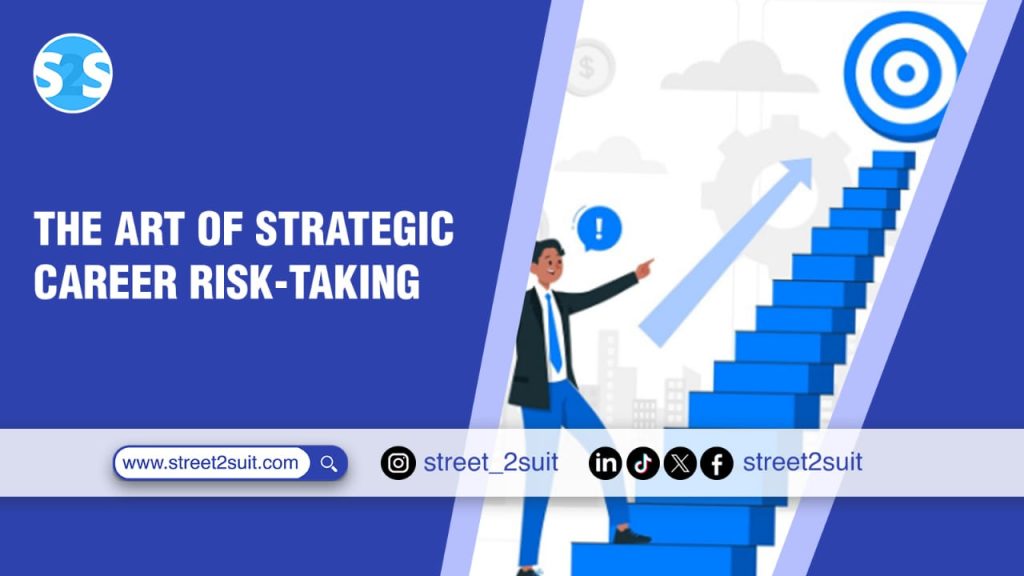Let’s talk about something intimidating—no, not Nigerian traffic or NEPA’s sudden mood swings, but something even more nerve-wracking: career risk-taking.
Before your anxiety kicks in and your inner voice starts screaming, “Just stay in that government job and manage!”—take a breath.
We’re not discussing reckless decisions like quitting your job to become a full-time cat influencer (unless you have a solid plan). We’re focusing on strategic risk-taking—the kind that transforms ordinary careers into extraordinary stories.
So, if you’re feeling stuck in the “safe zone” of your career, wondering whether to take a leap or quietly fade into your 9-to-5 until retirement, this essay is for you.
First, What Is Strategic Career Risk-Taking?
It’s not about quitting your job with no savings, a vague idea, or prayer. That’s not strategy; that’s an episode of “What Were You Thinking?”
Strategic risk-taking means making bold yet calculated moves in your career—moves that involve uncertainty but also the potential for significant growth. It involves saying, “This is scary, but if it works, it changes everything.”
You’re not betting everything on black; you’re playing chess. You’re making a move today that could position you three steps ahead tomorrow.
The Facts Don’t Lie
According to a study from the Harvard Business Review, individuals who take calculated career risks are more likely to advance to leadership positions and report higher job satisfaction. Why? Because comfort seldom leads to greatness.
Think about it: no one changes the world by sitting safely in the back row. The inventors, entrepreneurs, and leaders we admire— from Elon Musk to Oprah to Dangote— all take massive risks. The keyword here? Strategic.
They didn’t just leap; they launched. The comfort zone: That Seduce Trap. There’s a saying: “The comfort zone is beautiful, but nothing ever grows there.”
Staying in your current job feels safe. You know the system, the location of the restroom, and can scroll through your phone during meetings without scrutiny.
But deep down, you know something’s missing: growth, passion, purpose, and maybe even money. Let’s not pretend money doesn’t matter; your landlord certainly doesn’t.
So, how do you escape the comfort zone without crashing like a badly baked meat pie?
Step 1: Know Your “Why”
You don’t take risks for fun—unless you’re a YouTuber with a GoPro. You take risks to move toward something better.
Before making any career move, ask yourself: Why am I doing this? What do I hope to gain? What am I willing to lose?
Your “why” becomes your anchor. Without it, you’ll be blown away by fear, opinions, and that one cousin who always says, “Are you sure it will work?”
If your “why” is clear—whether it’s growth, impact, faith, or even escaping boredom—your risk becomes a mission.
Step 2: Start Small, But Smart
Taking a risk doesn’t always mean quitting your job and moving to Singapore. Sometimes it means:
- Starting a side hustle
- Going back to school
- Asking for a promotion
- Saying no to a toxic boss
These are small moves with a significant impact. You’re not burning the bridge; you’re quietly building a new one.
One effective strategy? The 70–20–10 model:
- Spend 70% of your time on your current role
- 20% on networking and learning
- 10% on something risky and new
This way, you don’t jump into the unknown; you slide into it strategically.
Step 3: Accept Failure as Tuition
Let’s get this straight: some risks may not pan out. But that’s not failure; it’s the cost of education.
Every failed business, awkward interview, and “No, thank you” email is teaching you something you can’t learn from a webinar.
Even Thomas Edison said, “I didn’t fail 1,000 times. The light bulb was an invention with 1,000 steps.” (Which may sound cool, but remember his workshop probably smelled like burnt wires for months.)
So, don’t fear failure—fear stagnation.
Step 4: Build a Safety Net (You’re Not Spider-Man)
Taking risks doesn’t mean taking foolish risks. You need a parachute. A Plan B. Maybe even Plans C, D, and E.
Before you leap:
- Save money
- Seek mentors
- Conduct thorough research
It’s not cowardly; it’s smart. Even trapeze artists have nets. You should too.
Step 5: Tune Out the Noise
Here’s a harsh truth: some people will not support your leap.
They might say:
- “You’re too old.”
- “You have children.”
- “At least you have a job—don’t be greedy.”
Smile, thank them, and keep moving.
People project their fears onto others, but their fears are not your future.
One day, they’ll say, “Wow, you were lucky.” And you’ll be able to smile and say, “No, I was strategic.”
Real Life: A Quick Case Study
Let me tell you about Sarah, a 32-year-old banker in Abuja. For eight years, she diligently worked with spreadsheets while secretly dreaming of becoming a chef.
Did she quit her job on a whim? No. She began by cooking for friends on weekends. Then, she started catering for small events. Over time, she built a client base, saved money, and took a professional culinary course. Three years later, she opened her own restaurant.
Now, she’s not just surviving—she’s thriving. And guess what? The same colleagues who once thought she was out of control now dine at her restaurant—and pay full price.
Conclusion: No Risk, No Story
Let’s wrap it up. A safe career might pay the bills, but a strategic risk? That’s where growth occurs. That’s where purpose can be found. That’s where compelling stories are born.
So, ask yourself:
- What bold step have I been avoiding?
- What’s my fear—and what’s my faith?
The art of strategic career risk-taking is not about being reckless; it’s about being brave with a plan. So, jump and make sure you learn how to land. And if you fall? Fall forward. At least you’ll have moved.
Remember—your dream is waiting… just on the other side of fear.
Receive the latest job and career updates in your inbox, every week!




